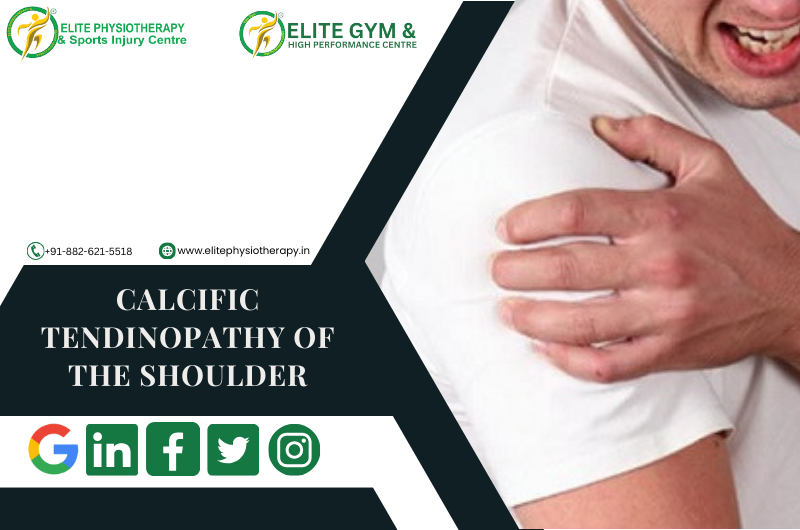Introduction
Calcific tendinopathy of the shoulder is a painful condition characterized by calcium deposits within the rotator cuff tendons, most commonly affecting the supraspinatus tendon. Our specialty at Elite Physiotherapy & Sports Injury Centre is offering thorough, scientifically supported physiotherapy treatments that are customized to meet the needs of each patient.
Causes and Mechanism of Injury
Although the precise etiology of calcific tendinopathy is still unknown, several elements are involved in its development:
- Degenerative Changes: Tendons may degenerate as a result of age-related wear and tear, increasing their vulnerability to calcium deposition.
- Repetitive Overuse: Overhead sports and jobs that require a lot of shoulder motions can make people more susceptible.
- Reduced Blood Supply: Healing may be impeded and calcification may be encouraged by decreased blood supply to the tendons.
- Metabolic Disorders: A higher frequency of calcific tendinopathy has been linked to conditions such as diabetes and thyroid issues.
The condition progresses through three stages:
- Formative Phase: The tendon starts to accumulate calcium deposits.
- Resting Phase: There may not be many symptoms and the deposits stay steady.
- Resorptive Phase: Inflammation and severe pain result from the body’s attempt to reabsorb the calcium.
Clinical Features
Patients with calcific tendinopathy often present with:
- Shoulder Pain: Usually restricted to the side or front of the shoulder, this pain gets worse as you move.
- Reduced Range of Motion: Having trouble raising the arm, particularly above the head.
- Night Pain: Pain that disrupts sleep, especially when lying on the affected side, may be a sign of an underlying issue.
- Muscle Weakness: Pain and inactivity cause the shoulder muscles to lose strength.
Diagnostic Approach at Elite Physiotherapy
At Elite Physiotherapy & Sports Injury Centre, we employ a thorough assessment protocol:
- Detailed History and Physical Examination: Understanding the onset, course, and nature of symptoms.
- Functional Assessment: Functional assessment involves evaluating shoulder strength, movement patterns, and functional limitations.
- Special Physiotherapy Tests: Clinicians use specific tests to distinguish rotator cuff involvement from other shoulder disorders.
- Imaging Referrals: In order to verify the existence and magnitude of calcific deposits, we occasionally work with imaging centers to arrange for ultrasound or MRI.
Comprehensive Physiotherapy Management
We design our physiotherapy interventions to alleviate pain, restore function, and prevent recurrence:
Manual Therapy
Hands-on techniques to improve joint mobility, reduce muscle tension, and enhance circulation in the affected area.
Therapeutic Exercises
Customized exercise programs focusing on:
- Range of Motion: Gentle stretching to improve flexibility.
- Strengthening: Targeted exercises for the rotator cuff and scapular stabilizers.
- Neuromuscular Control: Enhancing coordination and movement patterns.
High-End Modalities
We incorporate advanced technologies to optimize healing:
- Shock Wave Therapy: Non-invasive treatment that promotes reabsorption of calcium deposits and reduces pain.
- Capacitive Resistive Electric Transfer (CRET) Therapy: Enhances tissue healing through deep thermal effects.
- Super Inductive System: Utilizes high-intensity electromagnetic fields to stimulate tissue repair and pain relief.
- High-Intensity Class 4 Laser Therapy: Accelerates cellular regeneration and reduces inflammation.
- Hydrotherapy: Water-based exercises that minimize joint stress while improving mobility and strength.
- Cryotherapy: Application of cold therapy to reduce acute inflammation and pain.
We select each modality based on individual assessment to ensure safety and effectiveness.
Personalized Care at Elite Physiotherapy
Our approach is patient-centric, emphasizing:
- Individualized Treatment Plans: Tailored to the specific needs and goals of each patient.
- Education and Empowerment: Providing knowledge about the condition and self-management strategies.
- Ongoing Support: Regular follow-ups to monitor progress and adjust treatment as needed.
By integrating advanced physiotherapy techniques with personalized care, we aim to achieve optimal outcomes for our patients.
Conclusion
Shoulder calcific tendinopathy can have a major effect on day-to-day functioning and quality of life. Our thorough evaluation and state-of-the-art treatment methods at Elite Physiotherapy & Sports Injury Centre provide efficient ways to manage this illness. For a customized rehabilitation program, we encourage you to speak with our knowledgeable staff if you’re dealing with shoulder pain or dysfunction.

